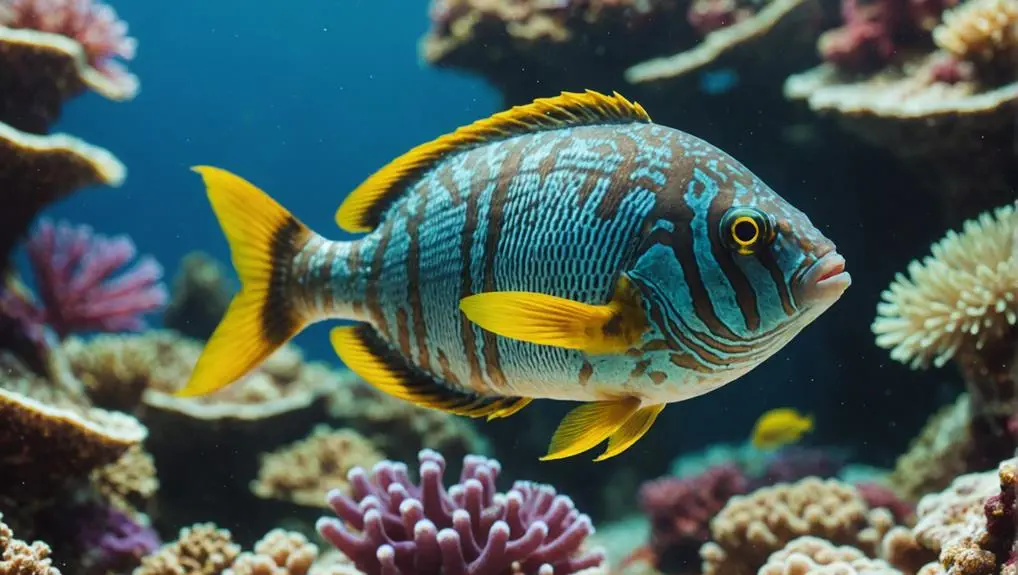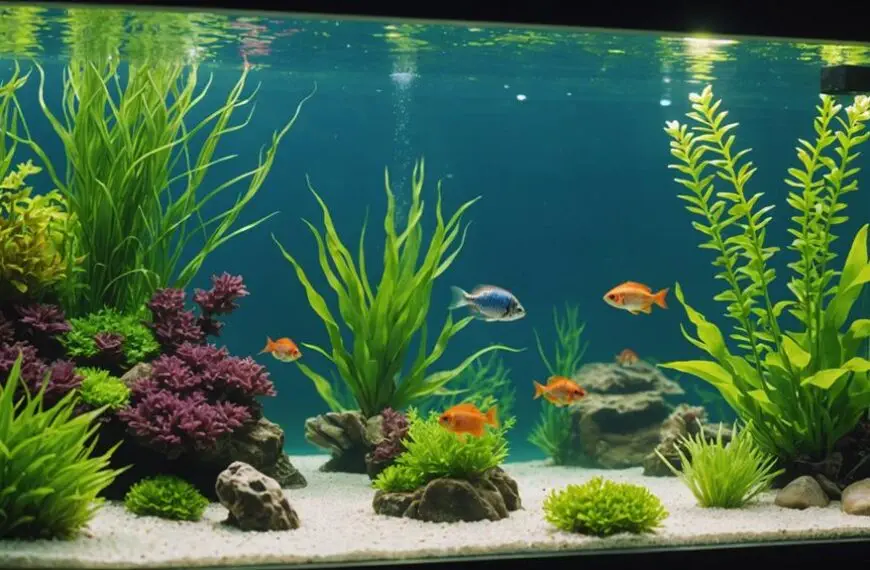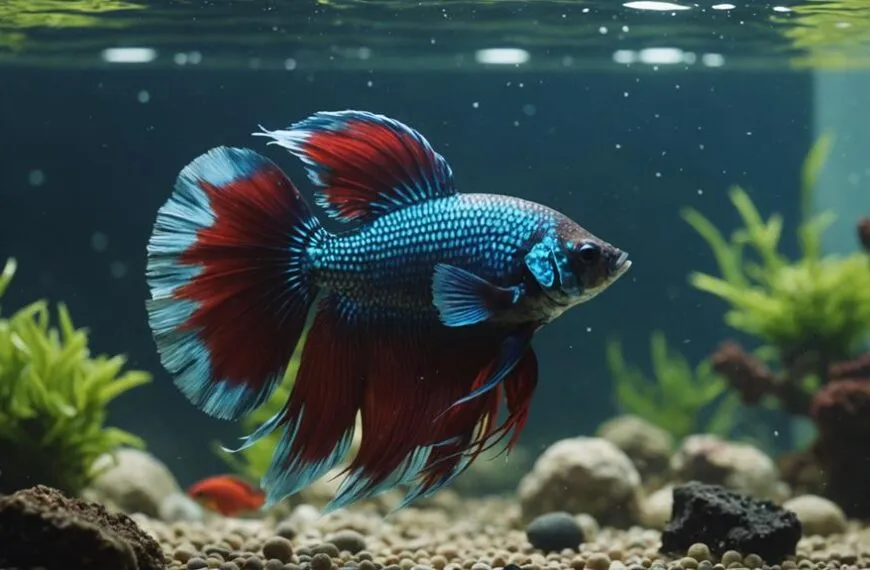To diagnose marine fish diseases effectively, you need to be observant and proactive. Start by checking for symptoms like scratching against surfaces, loss of appetite, or unusual breathing. Keep an eye out for physical changes like white spots or fuzzy growths; these can signal serious issues. Test your water quality regularly to ensure it's up to snuff, as poor conditions can lead to stress and illness. Using skin scrapes under a microscope can help identify pesky parasites. So gear up, play detective, and soon you'll be one step closer to keeping your aquatic pals happy and healthy! Want to know more?
Contents
- 1 Understanding Fish Diseases
- 2 Common Symptoms to Observe
- 3 Types of Infections
- 4 Visual Inspection Techniques
- 5 Diagnostic Tools and Methods
- 6 Water Quality Assessments
- 7 Skin Scraping and Microscopy
- 8 Identifying Behavioral Changes
- 9 Treatment Options Overview
- 10 Prevention and Maintenance Strategies
- 11 Frequently Asked Questions
- 12 Final Thoughts
Understanding Fish Diseases
When you dive into understanding fish diseases, it's essential to recognize that these ailments fall into four main categories: bacterial, viral, fungal, and parasitic. Each type can manifest in distinct ways, and knowing these differences can be your superpower in disease diagnosis and treatment.
For instance, bacterial infections might lead to unsightly lesions, while fungal infections often show up as fuzzy growths.
Water quality plays a critical role in your fish's health, so keeping it in check can significantly reduce the risk of marine fish diseases. If you notice your fish scratching against objects or behaving oddly, it can be a sign that something's off. Early detection is key; spotting these symptoms quickly can save you from a full-blown outbreak.
Don't worry if you're new to all this! A visual inspection can do wonders. Look for color changes or clamped fins, and remember that sometimes, a microscopic examination can help identify pesky parasites hiding out of sight.
With a little patience and attention, you can ensure your aquatic friends stay healthy and happy. After all, a thriving fish tank is a happy fish tank!
Common Symptoms to Observe
When you're observing your fish, keep an eye out for any unusual behaviors or changes in their appearance.
Things like increased scratching, color changes, or fish isolating themselves can be red flags that something's not quite right.
Behavioral Changes in Fish
A variety of behavioral changes in fish can signal potential health issues, making it crucial for aquarists to stay vigilant.
When you notice these changes, don't ignore them! Here are some common symptoms to observe:
- Scratching against surfaces – This often indicates irritation from parasites or skin infections. You'll want to keep an eye out for more symptoms.
- Isolated behavior – If your fish starts swimming alone instead of with the school, it could be a sign of stress or illness. Investigate, don't just shrug it off!
- Rapid gill movement and gasping – This might hint at gill problems or poor water quality. Testing the water is your next step.
- Loss of appetite – When fish stop eating, it's usually a red flag for various diseases. A health assessment is definitely necessary.
Notice any of these behavioral changes? Your fish could be sick and in need of immediate attention!
Addressing these issues early can help ensure your aquatic friends thrive in their environment, keeping your tank both healthy and happy.
Physical Appearance Alterations
Observing your fish's physical appearance is just as important as monitoring their behavior. You want to catch any physical appearance alterations early. For instance, if you see white spots on your fish's body or fins, they might be suffering from marine ich, a pesky parasite that loves to invade saltwater fish.
Keep an eye on your fish's skin color, too—changes like discoloration or hyper-melanization can signal stress or illness. Puffy, swollen eyes, often called popeye, are another red flag. This could mean your fish is dealing with some underlying health issues.
Don't ignore lesions or ulcers, either; these inflamed spots often indicate bacterial infections that need immediate attention. And if you spot fuzzy white growths, well, that's usually a sign of fungal infections, which thrive under poor water conditions.
Taking action quickly can make all the difference in your fish's health. So, stay vigilant and remember, your fish rely on you. After all, no one likes feeling under the weather—even our finned friends!
Environmental Stress Indicators
Environmental stress indicators in your marine fish can reveal a lot about their well-being. Keeping an eye on these signs can help you ensure your fish thrive in their environment. Here are some key symptoms to watch for:
- Increased scratching against tank surfaces – This often indicates irritation from parasites or poor water quality.
- Clamped fins and lethargy – These classic symptoms suggest stress, often linked to inadequate water parameters or aggressive tankmates.
- Rapid gill movement and gasping at the surface – This can point to compromised gill function from high ammonia or nitrite levels in the water.
- Discoloration or pigmentation changes – Look for fading colors or hyper-melanization, which reflect underlying stress factors like poor nutrition or water quality.
If you notice your fish isolating themselves, that's another red flag. It means they're feeling unwell, possibly due to environmental stress.
By being attentive to these signs, you can take action to create a happier, healthier habitat for your aquatic friends.
After all, a stress-free fish is a happy fish, and who doesn't love a cheerful little swimmer?
Types of Infections

Identifying the various types of infections that can affect marine fish is essential for successful treatment and management.
Your fish can suffer from bacterial infections, such as Columnaris and Aeromonas, which often lead to visible lesions, fin rot, and gill damage. Stress and poor water quality can make these infections even worse, so keeping an eye on your fish's environment is crucial.
Then there are fungal infections, like the fluffy white growths caused by Saprolegnia. These pesky fungi love to thrive in stressed fish, often in tanks that aren't well-maintained.
Next up, we've parasitic diseases, which are among the most common and deadly. Marine Ich and Marine Velvet can make your fish look like they're wearing a white coat or have a dusty appearance—definitely not a good look!
Recognizing the specific type of infection is key to effective treatment. For example, antiparasitic medications work wonders for ich and velvet, while antifungal treatments are what you need for those fluffy infections.
Stay vigilant, and you'll be well on your way to keeping your aquatic friends healthy and happy!
Visual Inspection Techniques
Visual inspection techniques are crucial in diagnosing marine fish diseases effectively.
Before jumping into treatment, you need to conduct a thorough visual inspection of your fish. Look for any signs that might hint at underlying health issues. Here are some key indicators to watch for:
- Discoloration – A color change can signal stress or illness.
- Lesions and Growths – Abnormal bumps or sores can indicate serious infections.
- White Spots – These pesky spots on fins or skin often point to parasites like marine ich.
- Behavioral Changes – Scratching against surfaces or swimming erratically can show that something's off.
Don't forget to inspect the fins and gills closely. Clamping or fraying can indicate respiratory problems.
Keeping an eye on the aquatic environment is just as important—regularly check water quality and conditions to ensure a healthy habitat.
Remember, it's about caring for these wonderful creatures. Your attentive visual inspection can make all the difference in their lives, helping them thrive in their home.
Diagnostic Tools and Methods
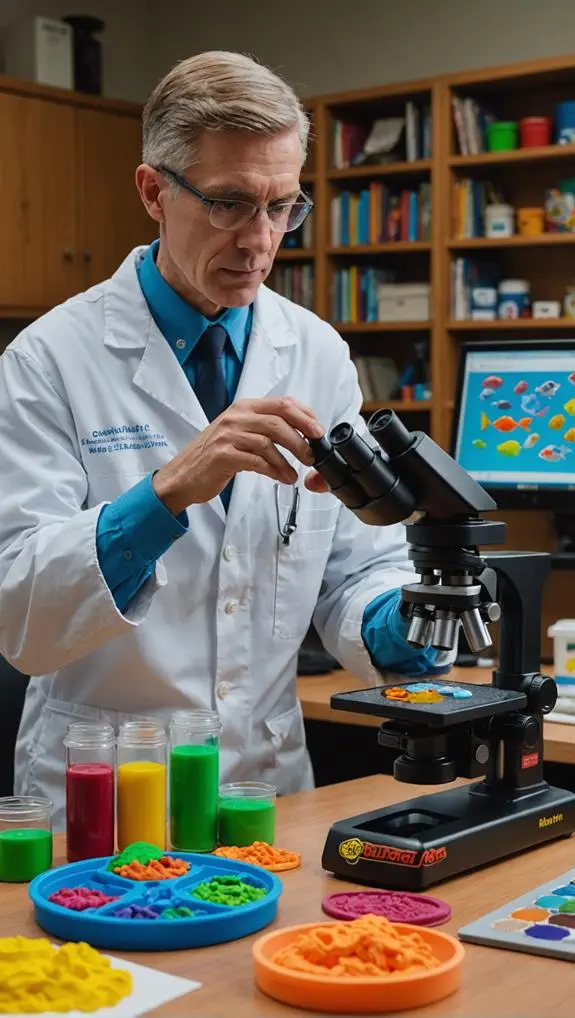
Diagnosing marine fish diseases requires a combination of effective tools and methods to ensure accurate results. First, you'll want to conduct water quality testing. Regularly checking ammonia, nitrate, nitrite, and pH levels is crucial because poor water quality can lead to fish stress and illness.
Maintaining balanced water quality is essential for ensuring your fish thrive. Once you've ruled out environmental factors, it's time to dig deeper.
Microscopy is your next best friend. By collecting skin scrapings, you can take a closer look at your fish. This skin scraping collection helps you identify parasites or fungal infections by observing cellular structures under a microscope. If you spot any creepy crawlies, you'll know exactly what you're dealing with!
Additionally, performing culture tests can be invaluable. Isolating bacteria from lesions can pinpoint the specific strains causing infections, guiding you toward the right treatments.
You're like a detective, piecing together clues to help your fish thrive.
Water Quality Assessments
When it comes to keeping your marine fish healthy, regular water quality assessments are a must.
Maintaining optimal levels of key water parameters such as pH, ammonia, nitrite, and nitrate is crucial to ensure a stable environment. You don't want to play a guessing game with ammonia, nitrite, and nitrate levels, since these sneaky pollutants can stress your fish and make them sick.
Importance of Regular Testing
Regular water quality testing is essential for maintaining a healthy marine environment for your fish. Think of it as a regular check-up for your fish tank, helping you diagnose potential issues before they escalate.
By frequently assessing your water, you can keep your aquatic friends happy and healthy.
Here are four key reasons why regular testing matters:
- Ammonia and Nitrite Levels: High levels can stress your fish and lead to disease. Nobody wants that!
- pH Stability: Fluctuating pH can make your fish feel like they're in a rollercoaster ride, increasing stress and health risks.
- Dissolved Oxygen: Just like us, fish need oxygen! Low levels can leave them gasping for breath.
- Temperature Control: Maintaining a steady temperature helps keep your fish's immune systems strong and ready to fight off infections.
Key Water Parameters
Maintaining optimal water parameters is key to ensuring the health of your marine fish. Regularly testing your water for ammonia, nitrite, nitrate, pH, and salinity is essential. Think of these elements as the building blocks of a happy, thriving underwater community.
For starters, keep ammonia levels at 0 ppm—yes, zero! Even tiny amounts can wreak havoc on your fish's immune system and lead to disease.
Next up, nitrite should also sit at 0 ppm. Elevated nitrite can mess with oxygen transport, making your fish feel as if they're swimming through molasses.
Nitrate levels? Aim for below 20-30 ppm. High nitrate can spark those pesky algae blooms that stress your fish out.
And don't forget about pH; it should be between 7.8 and 8.5. Deviations can leave your fish feeling off-kilter, like they've just missed their favorite TV show.
Skin Scraping and Microscopy

To effectively diagnose skin diseases in marine fish, skin scraping and microscopy are essential techniques. These methods help you uncover the underlying issues that could be affecting your fish's health. By carefully scraping a small sample of skin, you can spot pesky parasites, fungi, or other harmful organisms that might be lurking.
Here's what you should remember when you do skin scraping:
- Gentle Touch: Minimize stress for your fish; they'll thank you for it!
- Clear Samples: Use a saline solution on the slide to ensure everything is visible.
- Magnification Matters: A handheld or compound microscope with at least 40x magnification is key for spotting those sneaky parasites.
- Identify and Act: Knowing what you're dealing with, like Ich or flukes, allows you to take the right steps for treatment.
Microscopy is your best friend here! It lets you see the tiniest details, helping you identify specific parasites.
With the right techniques, you're not just diagnosing; you're giving your fish a fighting chance at a healthy life. So, gear up and dive into the microscopic world of fish health!
Identifying Behavioral Changes
Skin scraping and microscopy provide valuable insights into the physical health of your marine fish, but observing their behavior is equally important for diagnosing potential issues.
Keep an eye out for behavioral changes, as they can reveal a lot about your fish's well-being. For instance, if you notice your fish scratching against surfaces, it might be dealing with a parasitic infection like Ich or velvet. This calls for immediate attention!
Isolation is another red flag. If your normally social fish starts to swim away from the group, it might be stressed or feeling unwell. Rapid breathing near the water's surface isn't a good sign either; it often points to respiratory distress or gill damage, typically linked to poor water quality or parasites.
Moreover, if your bold fish suddenly loses its spunk, it's time to investigate. Changes in eating habits, like refusing food or being lethargic during feeding, are also critical indicators of sick fish.
Treatment Options Overview
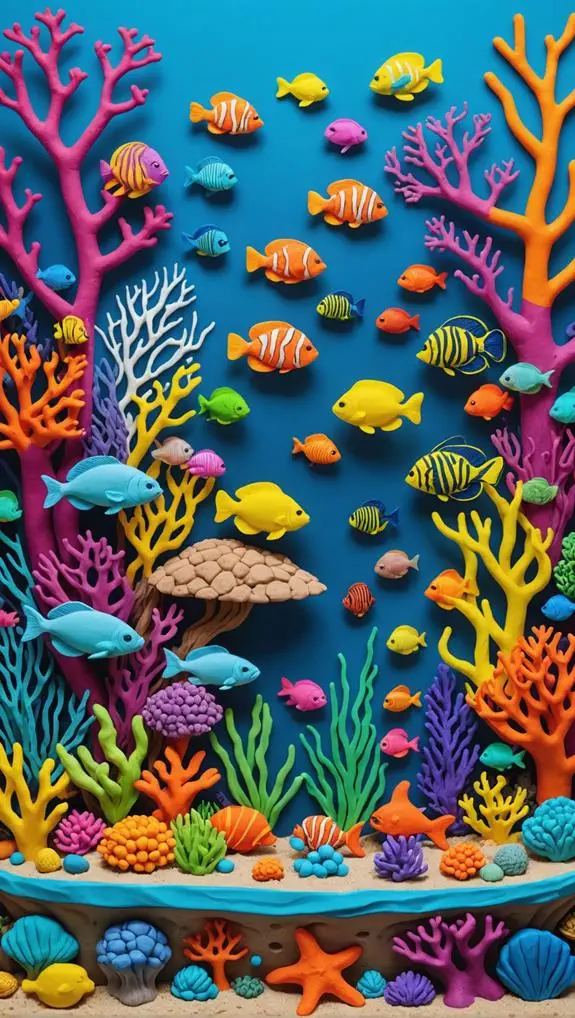
When your fish aren't acting right, knowing how to treat them can feel overwhelming, but it doesn't have to be!
From using the right medications to understanding the importance of quarantine practices, there are several effective options to help your finned friends.
Let's explore some common treatment methods, so you can get your aquatic buddies back to their happy selves in no time!
Common Treatment Methods
Effective treatment methods for marine fish diseases are crucial in maintaining a healthy aquarium environment. When you notice your fish acting strangely or displaying symptoms, it's time to take action.
Here are some common treatment methods you can use:
- Quarantine Tank: Isolate affected fish to prevent disease spread and focus your treatment efforts.
- Antiparasitic Treatments: For issues like marine Ich, copper-based medications and freshwater dips can help eradicate those pesky parasites.
- Bacterial Infections: Use broad-spectrum antibiotics like Kanaplex or Furan 2 to target specific symptoms like lesions or gill damage.
- Fungal Infections: Antifungal medications, such as API Pimafix or Kordon Malachite Green, can tackle those cotton-like growths on your fish.
Don't forget about salt baths! They can reduce osmotic stress and kick those external parasites to the curb.
Remember, your fish depend on you to create a safe and healthy home. By using these treatment methods, you'll not only help your fish recover but also create a thriving aquatic community.
Plus, there's nothing quite like watching them swim happily again!
Medication Types Available
Several medication types are available to tackle marine fish diseases, each designed to address specific health issues. When you notice your fish isn't acting quite right, it's time to consider the options.
Antibacterial medications like Kanaplex and Furan 2 are great for battling bacterial infections such as Columnaris and Vibriosis. Think of them as your fish's personal bodyguards!
For fungal troubles, products like Kordon Malachite Green and API Pimafix can help clear up those pesky cotton-like growths.
And when it comes to pesky parasites, antiparasitic solutions like Copper Power and formalin dips can really save the day by targeting Marine Ich and Marine Velvet.
Salt baths are another handy treatment for external parasites, offering relief and reducing stress for your fish. Just imagine a soothing spa day!
Quarantine Practices Importance
Before introducing new fish to your main aquarium, practicing proper quarantine is crucial. This vital step helps you spot and treat any potential diseases, keeping your aquatic family safe and healthy.
Think of it as a welcoming committee for your new fishy friends!
Here's why quarantine should be your best buddy:
- Disease Prevention: Quarantine helps you catch any external parasites or illnesses before they spread to your established tank.
- Healthy Environment: Keep your newcomers in a separate tank for 2-4 weeks, where you can monitor their health and stress levels.
- Medicated Dips: Utilizing a freshwater dip can help eliminate pesky parasites, ensuring you don't bring unwanted guests to your main aquarium.
- Compatibility Check: You'll get to know your new fish better, making it easier to decide if they'll get along with your existing tank mates.
Prevention and Maintenance Strategies
Implementing prevention and maintenance strategies is crucial for keeping your marine fish healthy and disease-free. Start by setting up a quarantine protocol for any new arrivals. Isolating them for at least 2-4 weeks helps ensure they're not carrying any hidden illnesses that could spread to your established fish.
Next, regularly monitor water quality parameters like ammonia, nitrate, and pH levels. These factors directly impact your fish's well-being, and maintaining optimal conditions can lower stress, which is a major vulnerability for fish.
A balanced diet is also key—high-quality nutrition boosts their immune systems, making them more resilient against diseases.
Don't forget about tank overcrowding! Avoid cramming too many fish in one space, as this can lead to stress and even aggression.
Routine tank maintenance is essential, too. Regular water changes and substrate cleaning create a healthy environment where your fish can thrive.
Frequently Asked Questions
What Are the Diagnostic Techniques for Fish Disease?
When diagnosing fish disease, you'll observe symptoms closely, assess environmental factors, and utilize various treatment methods. Regular inspections and water testing can help you identify issues early, ensuring your fish receive the care they need.
How Do You Test for Fish for Diseases?
To test for fish diseases, you'll need to balance symptom recognition with water quality assessment. Inspect for abnormalities while ensuring your tank conditions are optimal, as both play crucial roles in maintaining fish health and vitality.
What Is the Best Method to Identify Parasite Species in Marine Fish?
To identify parasite species in marine fish, observe symptom patterns and consider environmental factors. Use effective microscopy techniques to confirm findings, then explore treatment options that promote the fish's health and wellbeing.
How Do You Identify a Marine Ich?
To identify marine ich, look for ich symptoms like white cysts and abnormal behavior. Consider treatment options like copper medications, and implement prevention strategies, such as maintaining water quality and reducing stress in your aquarium environment.
Final Thoughts
So, whether you're spotting a fish with a funky fin or just feeling a bit fishy yourself, diagnosing marine fish diseases doesn't have to be a daunting task. With a keen eye and some handy tools, you can tackle those pesky problems head-on. Remember, a little prevention goes a long way, so keep your tank clean and your fish happy. After all, a healthy fish is a happy fish—and who doesn't want that? Dive in, and good luck!

